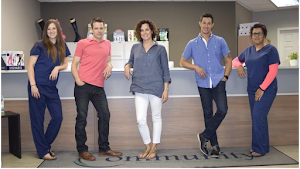by Sarah Dale
Share

Shockwave therapy is a non-invasive treatment that involves creating a series of low-energy acoustic wave pulsations that are directly applied to an injury through a person’s skin via a gel medium. The concept and technology originally evolved from the discovery that focused sound waves were capable of breaking down kidney stones and gallstones.

You don’t need painkillers with it – the purpose of the therapy is to trigger the body’s own natural healing response. Most people report that their pain is reduced and mobility is improved after the first treatment.
HOW DOES SHOCKWAVE THERAPY WORK?
For orthopaedic conditions, shockwaves are used to induce neovascularization (formation of new blood capillaries) at muscle/tendon junctions. Shockwave therapy also causes the body to naturally release healing chemicals that help to improve cellular proliferation and tissue regeneration which are both vital in the healing process.
The result of Shockwave therapy is relief of stubborn, chronic tendinopathy. There are some tendon
conditions that just don’t seem to respond to traditional forms of treatment, and for this, Shockwave therapy is a wonderful and effective treatment.
Shockwave therapy is most suited for people who have chronic tendinopathies (commonly referred to as tendinitis) including: plantarfasciitis/heel spurs, tennis elbow, Achilles tendonitis, rotator cuff tendonitis, jumpers knee and calcific tendinitis of the shoulder. These could be a result of sport, overuse or repetitive strain.
WHAT TO EXPECT…
At your first visit at CCC, you will be assessed to confirm that you are an appropriate candidate for Shockwave therapy. Dr. Sarah or Dr. Todd will ensure you are educated about your condition and what you can do in conjunction with treatment which may include activity modification, specific exercises, assessing any other contributing issues such as posture, tightness/weakness
of other muscle groups, etc.
Shockwave treatment is usually done once a week for three to six weeks, depending on results. The treatment itself can cause mild discomfort, but the treatment is only three minutes long and the intensity can be adjusted to keep it comfortable.
After the treatment, you may experience temporary soreness, tenderness or swelling for a short time
following the procedure, as the shockwaves stimulate an inflammatory response (but this is the body healing itself naturally).
Upon completion of your treatment you can return to most regular activities almost immediately.
CASE #1 – JE
JE is a long distance runner who came to CCC suffering with knee pain and foot pain that was
worse when she ran. Examination showed that she was suffering with knee pain caused by tightening
of the tendons on the side of her knee (Iliotibial Band Syndrome) as well as foot pain caused by
plantarfasciitis. From her history, it was concluded that the knee pain was only secondary to the real
problem: her plantarfasciits. JE was treated with Shockwave once weekly for five weeks.
After one treatment, the knee pain was gone and JE was able to run without knee pain. The foot pain
was resolved a bit more slowly as it was the real source of all the discomfort, but after a total of five
visits, JE was running pain-free!
CASE #2 – RF
RF presented to the office with chronic shoulder pain that had progressed so much that she was no
longer able to raise her arm above shoulder height, or reach back to scratch her back. Her assessment
revealed that RF was suffering with chronic rotator cuff tendonitis which was slowly becoming a “frozen shoulder.” Diagnostic ultrasound confirmed calcific tendinosis of the rotator cuff as well as biceps tendon.
Treatment for RF included Shockwave once weekly for four weeks as well as prescribed exercises and
other supportive treatment.
After four weeks of care, RF has full shoulder range of motion and has moved onto the strengthening
portion of her treatment plan.
CASE #3 – JC
JC is in construction and was feeling elbow pain all summer. He felt the most discomfort when he
was gripping his drill or his hammer. By the time he presented to CCC, he could barely hold his coffee
cup.
The diagnosis of chronic tennis elbow was easily made and treatment of Shockwave therapy was
prescribed.
JC was thrilled to feel relief after one treatment and by the fifth week, he was working pain-free!
Book your no charge consultation now to see if Radial Shockwave can help you!

